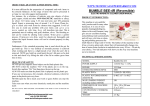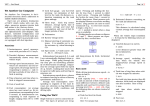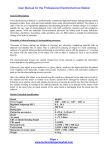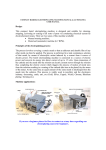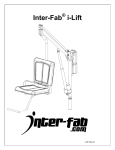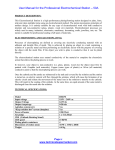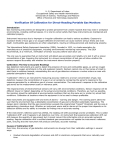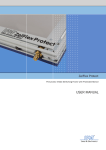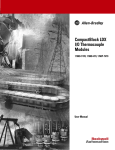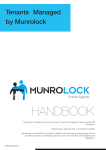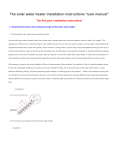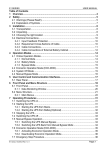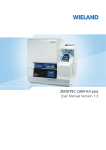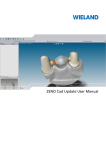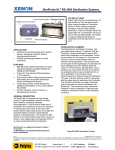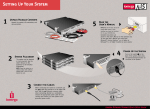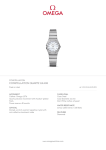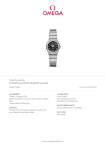Download Compact Electro Plating Machine - CEPM-4
Transcript
4 1 Installation and operation of this unit does not require in-depth professional knowledge or specific training. Just fill the “Keep Solution Hot” system with 250 ml of hot-tap or boiled water, connect this unit to a the power supply, fill all tanks with required solutions (50 ml each tank) and place them in three holes on the front of the unit. Now place the correct anodes, connect the plating objects to the cathode rod using copper or aluminium wire (hooks), connect both, 4 mm anode and cathode rods to the power supply using red and black crocodile clamps, switch the unit “On” (turn a potentiometer with a knob clockwise) and start your works. That’s it. To start electroplating / electroforming you will probably also need the following: - Some additional anodes such as a rhodium plating anode for rhodium plating process (supplied separately on request due to prices changing every day). Copper and nickel anodes for copper or nickel plating processes. - Sufficient amount of distilled or deionised water (water for car acid batteries is suitable) to stir chemicals with. - Cleaning/Plating/Forming chemicals depending on process you require. - Copper or aluminium wires (hooks) to connect the objects to the cathode rod. - Rinsing water in glass or plastic container or, alternatively, easy access to tap water. STARTING YOUR WORK: When your unit is fully prepared to work (when all solutions, plating objects and anodes are already in tanks; both 4 mm anode and cathode rods are connected to the powers supply using the red and black crocodile clamps (connect them to “crocodile clips points” on Picture No:3) and the “Keep Solution Hot” system is filled up with hot-tap or boiled water just switch the unit “On” by turning the potentiometer (Metallic knob with 0-9 digits) clock-wise and move it to the correct position (1 digit = 1.5V) for your work to supply a voltage to the cathode/anode rods. Please note: the current will be shown on a gauge (in the middle of top panel) only when the electroplating process has started -“Plating-Stripping” switch is on “Plating” position and both ANODE and CATHODE (object to be plated) are in the solution. Please also note that most processes require just 1-2 A per 1 sq. If your gauge stays on “0” position its mean that in your tanks is less then 1 A. If you see that the gauge starts to show more than 1 A then increase distance between the anodes and the objects to be plated in all tanks or reduce the voltage using potentiometer (turn it anti-clockwise). WWW.TECHNICALSUPERMARKET.COM Compact Electro Plating Machine - CEPM-4 INSTALLATION AND OPERATION: USER MANUAL PRODUCT INTRODUCTION: This compact electroplating machine is a high performance plating/forming unit that is designed to plate Rhodium and all other precious metals; to form; strip and clean objects (with dimensions approximately one cubic inch) using an electrochemical method. This appliance incorporates principles of modern design.. Electrochemical processes are widely used in many industries such as electronic, machinery, decorating, crafts, jewellery, arts, etc. Most popular plating processes are: rhodium; gold; silver; nickel; copper; yellow passivate; brass; DELIVERY SPECIFICATIONS: This unit with black and red leads (crocodile clamps); 3x50 ml plastic tanks with lids; anode and cathode, 4 mm metal rods x 2; drain rubber plug x 1; stainless steel, copper and nickel anodes with protective plastic mesh for cleaning, copper, nickel, gold, silver, chrome and rhodium plating processes. Model CRPM-4 Input (V) 110V – 240V ac Output (ADC) 0-12 V dc / 0 - 4 A continuously Keep Solution Hot option (water) Yes Plating-Stripping option Yes Overload power cut-off system Yes Power / Voltage indicator Yes Ampere gauge Yes (0 – 4 ADC) Plating line parameters (Output) 0-12Vdc/0A-4A continuously HEALTH AND SAFETY: Anode’s rod Yes, 4 mm All Electrochemical processes are subject to two main hazardous effects: electrical injuries and poisoning by solutions and their gases. To avoid electrical injuries the user must not touch any exposed leads of the station with unprotected hands. Always use rubber gloves. This will also protect your hands from the harmful effects of the solutions. It will also be necessary to provide a rubber mat to stand on in the operation area. The chemicals which you will work with are hazardous; many of them are deadly poisons and their combinations often produce corrosive and poisonous gases. Therefore, all general safety precautions should be undertaken when working with them including keeping all chemicals inaccessible to children, wearing eye protection, avoiding skin contact, wearing latex gloves and avoiding inhalation. Proper ventilation of the work area is essential. Appropriate rules of working with chemicals are provided by the suppliers of every chemical. Please follow all instructions carefully. Cathode’s rod Yes, 4 mm Plating line x 1 Tank’s lid Yes x 3 Solution tank 3 Volume of each tank 50 ml Dimensions of each tank (mm) 50 (D) x 60 (H) Tank’s material Polypropylene Dimensions of station (mm) 235(W) x 165(D) x 170(H) Weight 0.9 Kg If you find cleaning, electroplating, electroforming or stripping processes challenging please feel free to contact us regarding a downloadable electroplating courses for beginners! [email protected] Customer Support Worldwide: +44 (0)800 059 9607 www.technicalsupermarket.com BRUSHES AND PENS: The unit has an electrical line (outputs) enabling Brush or Pen plating as well. In order to do this, connect the pen (brush) to the positive “+” (red crocodile clamp) lead. Connect the negative power source “-” (black crocodile clamp) lead to an object to be plated. For a brush (Pen) stripping process please use IMPORTANT! If the received unit looks a little different from the model that you expected, please do not worry: changes that have been made are solely made with the purpose of improving the quality, appearance and specifications 2 3 ASSEMBLY: THE “Keep Solution Hot” SYSTEM: Both, anode and cathode 4 mm rods (Picture No:1) are fully movable and can be taken out at any time when required to clean tanks after the plating process is completed, to fill tanks with fresh solutions or you want to fill up the “Keep Solution Hot” system by hot tap or boiled water. If these rods already are on their position please connect a positive power (using a crocodile clamp/clip on the red lead) to 4 mm ANODE rod (please see picture bellow) and a negative power (using the crocodile clamp/clip on the black lead) to a 4 mm CATHODE rod. Now connect the correct anodes (to the ANODE rod) as shown on a picture on next page. It is a very simple safe and useful heating option that allows you to save money on electricity. When you require increasing temperature of solution inside tanks just add about 250 ml of hot enough or boiled water inside the unit (Picture C). IMPORTANT! Please make sure that all anodes are in the protective plastic mesh in order to avoid any contact with the objects to be plated/cleaned (short-cut). Now dissolve the chemicals in the correct amount (50 ml) of warm (50C-60C) distilled water, mix them very well and pour the solutions into the tanks. For example, fill the left tank with cleaning solution and the second tank with tap (rinsing) water and the right tank with a rhodium plating solution. (All tanks can be also used in different ways, for example, for cleaning or plating/forming solution in all three tanks). Now attach a correct type of anode for each tank to the anode’ rod as shown on top picture on next page. Your machine is ready to work. A When you want to use this system or already to change this cooled water on the system just unplug a drain rubber plug on the bottom of a side wall on the unit (please see Pictures A) and pour all cooled water out from the unit in a suitable container (Please see picture B). Then place this rubber plug back on its place, take out ANY one NOTE: It is very important to B C keep temperature of your solutions under The rule of thumb is that the anode should be about twice bigger in size then area of plating object and depending on the plating process (rhodium, gold, copper, chrome etc) the anode material will vary. If the object you wish to be plated is bigger than the anode them a Cathode Rotating Stand or 2 - 4 anodes around the plating object should be used in same time to get an acceptable plating result. control this because if tem perature reaches more than ITEMS PREPARATION: CLEANING PROCESS 75 C (167 F) it will To prepare the items for quality electroplating or electroforming process it is important to ensure that all oil, grease, paint, old layers or other materials are removed prior to processing. The most common cause of poor quality plating or forming is insufficient preparation. The usage of an electromagnetic or ultrasonic cleaners is excellent for the purpose of removal of some grease or polishing compounds. However, vigorous brushing with soapy water is sufficient. You can also electro-clean these objects in the tank. This electro-cleaning process takes just a few minutes and this is a very short period of time compared to the time you may waste trying to plate an object which was not sufficiently cleaned. In order to perform the cleaning process the object to be plated should be hung on the cathode rod (please see picture bellow) using a hook made from copper or aluminium wire. destroy Please make sure that the cleaning item is fully immersed in the cleaning solution and have a good contact with the cathode rod. Connect this rod (see a picture on next page) to a negative power supply using the black crocodile clamp. Now connect the stainless steel anode on the anode rod and connect this rod using the red crocodile clamp of positive power supply. Then make sure that the “Plating – Stripping” switch is on the “Plating” position. Now switch this unit “On” and turn the potentiometer (left knob with 0-9 digits) to the required voltage (usually about 9-12 Volts) and commence the process. You can repeat this procedure as many times as you want. your solu- STRIPPING OPTION: This process is widely used for removal of all residues or unwanted layer fro m a previously plated object. For this process the object go i n g to be stripped needs to be hung on hooks made of copper or aluminiu m wire to the ANODE rod (positive power supply) and connect an anode to the CATHODE rod (negative power supply). O n t his mac hine it can be done automatically without changing the object’ and anode’s position by sw itc hi n g “Plating-Stripping” switch on top front panel of the machine to the “Stripping” position. Once again there is no need to reverse the polarity of the cables manually as the unit does this automatically for you - just make sure that the s t r i p p i n g item and an anode are fully immersed in the solution and have a good contact with its 4 TERMINOLOGY FOR BEGINNERS: Anode and Cathode: Throughout the User Manual we refer to the terms anode and cathode a lot. Please do not be put off by this. AN ANODE is the piece of metal in the tank which should be connected to the plus (+) or positive power and A CATHODE is the object that needs to be plated and that should be connected to the minus (-) or the negative power. The “Keep Solution Hot” heating system is a system that allows you to keep your rhodium and other precious metal solutions in a tank hot enough to get a high quality plating surface within the best possible time. Usually this temperature is between 50 C and 70 C. This electroplating unit is supplied with an integral PP-welded water-proof non-movable container (under three plating tanks) which allows pouring and holding of about 250 ml (when tanks are placed on their holes!) of hot tap or boiled water and sufficient for keeping your solution in three tanks hot enough (up to 70 C) for about 45-60 minutes which is fully sufficient for any type of electroplating process. DO NOT overfill! Hot tap or boiled water can be poured in any tank’s hole – please see Picture 2 and make sure later that all three tanks are properly placed back in their holes. To do these just move those tanks around in their holes manually. Do not press them down. DC power cut-out system - this model has an overload DC power cut-out system that allows the unit to remain in full working order if an accidental shortcut occurs. (The anode and cathode connected together in a solution for a period of up to 10 seconds).



